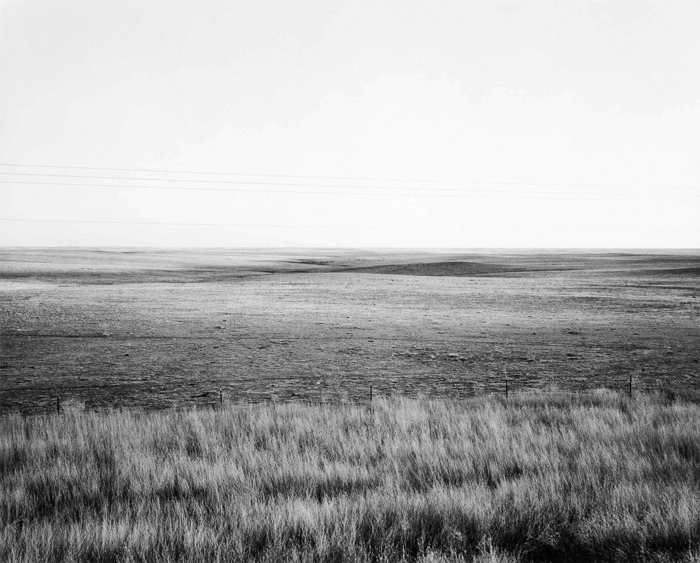
Robert Adams, Lincoln County, Colorado, Negative 1977, Printed 1979. Gelatin silver print; Image: 8 15/16 x 11 inches. Collection of The J. Paul Getty Museum, Los Angeles, California, © Robert Adams.
“Landscape,” art historian Malcolm Andrews has written, “can mask the land.”1 Cultural constructions of nature, then, can be seen as revealing more of an environmental or artistic ideology than an accurate assessment of nature. Robert Adams: Landscapes of Harmony and Dissonance invites such a critical read through the artist’s changing representation of natural sites. The exhibition divided thirty years of Adams’ photographs of the West into three distinct periods: the “New West” of Colorado, where he had grown up and later returned to in the late ‘60s and ‘70s; images taken in the Los Angeles basin throughout the ‘80s; and those photos from the last decade taken in the area where he has been living with his wife, environmentalist Kerstin Adams. To provide context for Adams’ work, the Getty Center included a small group of historical western landscape photographs that gave access to the roots of Adams’ work as well as a means to examine how the genre has been transformed.
Coupled with a recent video commentary concerning his latest work, the expansive survey revealed the artist’s anxiety reconciling the beauty and undeniable power of form he discovered while capturing the ruination of western spaces by real estate developers, the nuclear industry, and timber operations. A prolific writer, Adams recognized early the uneasy truce artistic aesthetics must make with the devil when environmental harm is documented. Adams eloquently debated the difficulties and inadequacies of art photography to deal with social ills in his 1981 essay “Photographing Evil”:
I had contracted to picture extractive industries in Colorado, and in the process I had photographed pits cut by swirling roads as graceful as Robert Smithson’s earthwork Spiral Jetty and rock faces so powerful and serene they reminded me of classical buildings…but I was left at the end of the day with a sense of the certainty of evil, of the ambiguity of what photography could do with it, and of the fact of my own limited skills.2
Overall, the arc of his exhibition at the Getty paralleled the shift from a disengaged, autonomous Modernism with its “smooth aesthetic façade acting as a coverup of social reality,”3 a history of which Thomas McEvilley describes as “the thin pure stream that had nothing to do with anything else,”4 to a Postmodernism that reverberates with a consciousness about art’s role in the debate over pressing world matters.
Landscapes of Harmony and Dissonance provided both testament to the quickening pace of American environmental degradation and opportunity to interrogate how Adams has grappled for over thirty years with such thorny subtexts as whether one’s art credentials are sacrificed when a more direct, apologetic approach to environmental problems is assumed or whether an aesthetic approach to photography lifts the moral imperative to indict or intervene against ecological crimes depicted in images. A question arises: can a meaningful balance between conscience and art be achieved?
In 1981, having finished an extensive series of photographs to document the mushrooming tract housing developments in rural Colorado, Robert Adams wrote, “…Sincerity is often in at least some senses a negative attribute in an artist, who by definition is looking for Form [my italics], for overall shape in life beyond the limits of immediate social or economic or political conditions.”5 Adams seemed to express the prevailing attitude among earthwork artists such as Michael Heizer and Robert Smithson that an expansive, heroic exploration of form was the progressive prerogative of art, even if it meant destroying and forever altering pristine land.
At the time, photographing geometric forms to mimic reductive painting had become a mainstay for artists such as Ralph Gibson. To legitimize photography as cutting edge, many others were skewing their work towards a Greenbergian formalism that then dominated the vanguard. Positioned alongside photographers of the western landscape such as Lewis Baltz and Joe Deal, Adams made works in that period which seemed, like those of earthwork artists, to pose more of a projection of formalist language onto the landscape than present a political engagement with the forces that were dismantling these fragile places.
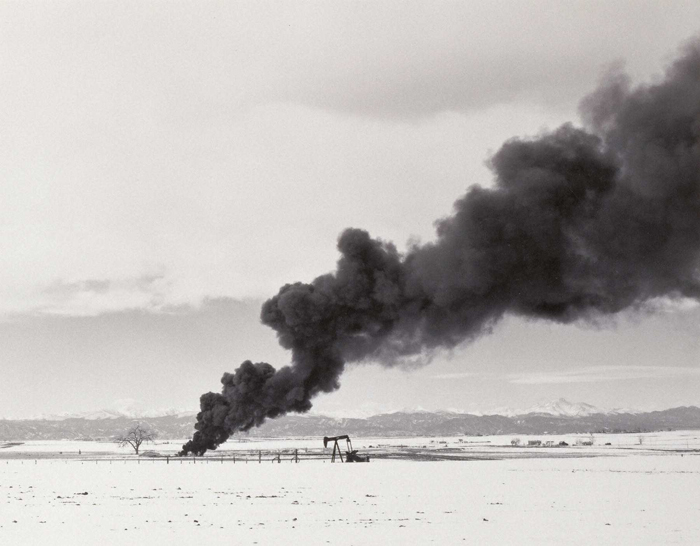
Robert Adams, Burning Oil Sludge North of Denver, Colorado, 1973. Gelatin silver print; Image: 6 x 7 5/8 inches. Collection of The J. Paul Getty Museum, Los Angeles, California, © Robert Adams.
“What kind of life do [photographs] promote?” Adams has asked.6 His work from the ‘70s clearly shows its youthful allegiance to formalist dogma that prevailed over didactic concerns of the day. Of Burning Oil Sludge North of Denver (1973), Adams noted the “unexpected beauty”7 of an oil well spewing a large diagonal plume of churning black smoke from a snow covered field backed by a vast, distant mountain range. A “grasshopper” oil pump is dwarfed by the enormity of the setting. Indeed, in this striking photograph—an inky Rorschach that wavers between depicting the defilement of pristine nature and mimicking countless Tony Smith style minimalist sculptures that concurrently wended their way through the landscape— Adams laid out the horrifying sublimity of oil extraction. However, any indictment of the industry or impetus to act seems neutralized, abstracted and subsumed by the universal— and pleasurable—play of black against white, evil against good. Should we not require that he make this event repugnant?
During the same era, Adams was exploring new housing tracts in Colorado. What seemed to attract him most was the light: “Even subdivisions, which we hate for the obscenity of the speculators greed are at certain times of the day transformed to a dry, cold, brilliance.”8 Countless small-scaled pictures from 1973 evince Adams’ esteem for formal geometric abstraction: clean, new freeways and overpasses, not yet clogged in dystopic traffic. Compositionally, they rival Charles Sheeler’s factories or Margaret Bourke White’s coal rigs and plow blades. Brilliant sky and earth are given equal play in so many of these pictures and are as starkly divided as any two colors in an Ellsworth Kelly painting. Old houses punctuate agricultural fields, while billboards and stacks of plywood and building materials are strewn over the desolate earth like the overlapping planes of a Hans Hofman composition.
Many of the night pictures from that era share a similar painterly, abstract drama: Next to Interstate 25 Near Longmont, Co. (1977)—with its two light poles running down the center of the picture and light streaming from the top—comes as close to a Barnett Newman painting as any photograph could. Freshly built suburban houses with requisite RV’s sit in hardscrabble earth; the pale sky is crisscrossed by electrical wires and wispy clouds; the barren land is tracked by thin roads and barely perceptible cattle paths that altogether call to mind the fine pencil lines and Minimalist aesthetics of a 1970 Robert Mangold.
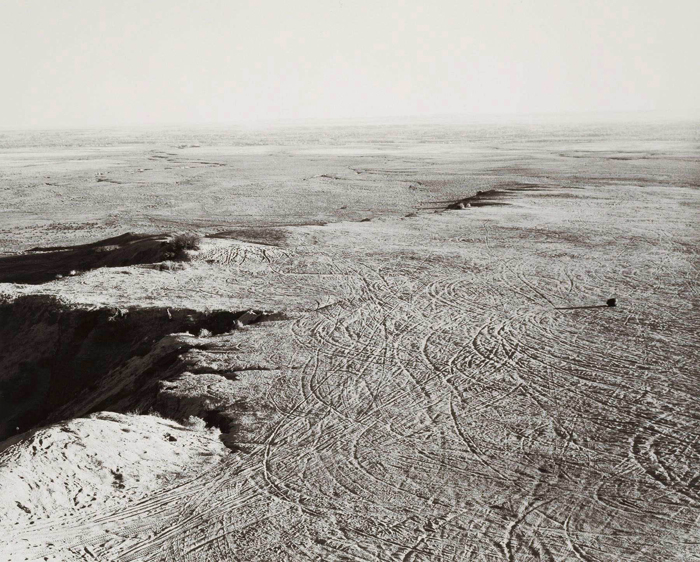
Robert Adams, Quarried Mesa Top, Pueblo County, Colorado, 1978. Gelatin silver print, Image: 15 x 18 3/4 inches. Collection of The J. Paul Getty Museum, Los Angeles, California, © Robert Adams.
In Quarried Mesa Top, Pueblo, Colorado (1978) a vast dirt foreground area sports a fine web of vehicle tread marks. The background is filled with a cookie-cutter ‘70s stucco housing development. Adams presents the scene as personless, perhaps because human presence would destroy his composition’s placid formal, abstract beauty. The setting he depicts seems disquieting although not in any urgent way, epitomizing the “harmony and dissonance” of the show’s title. Though suggesting the inhabitants of this area may be tucked back into their boxes for the evening to escape their bleak relationship to the soil—which consists not of tilling and cultivating but, diabolically, of tearing it up, perhaps in revenge for their alienation—Adams has given us a certain solace in geometric form and gorgeous tonal variations to assuage our indignation. “All land, no matter what has happened to it has over it a grace, an absolutely persistent beauty,” he wrote.9 Even if we are powerless to stop this violation of the land because the “enemy” is never actually caught in the act, he seems to say, we can always recompose or appreciate it as art.
Of course, Adams’ work, like that of many of his landscapist peers of the period, was a radical departure from the Ansel Adams model of the immaculate western scenic landscape, unblemished by man’s presence. Ansel Adams’ work optimistically and gently nudged us towards conservation of wild places with their sanctifying insistence on natural beauty. What Robert Adams shares with the elder photographer is consummate regard for his craft.
Where he diverges, however, from Ansel Adams is in his aesthetic approach to representing the mutilation of the land. Beautiful images of destruction never arose in Ansel Adams compositions—his artistic approach to subject matter was consistent regardless of whether he was presenting an escapist balm about the West or actual documentation. Younger art photographers undoubtedly had to contend with a more endangered environment than he did. Robert Adams chose to defiantly represent civilization’s collisions with open space. His inclusion of the debasement of the landscape “undid” Ansel Adams’ dreamy fictions as much in the service of truth telling as for the formal possibilities. However, his willingness to engage complex and troubling issues without abandoning his considerable craft and artistry continues to resonate into the present.
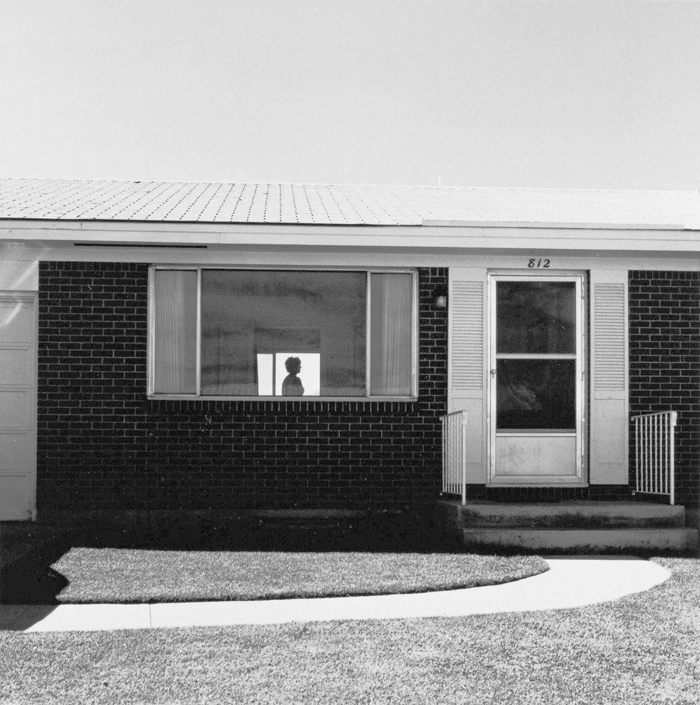
Robert Adams, Colorado Springs, Colorado, 1968-70. Gelatin silver print; Image: 6 x 5 15/16 inches. Collection of The J. Paul Getty Museum, Los Angeles, California, © Robert Adams.
When a rare person appears, as in an undated print entitled Colorado Springs, Co. (1968-70), the obsessive geometric organization and composition of the picture underscores the implied content rather than detracts from it. The front of a plain-wrap tract house fills the center of the small picture; a cloudless sky and a curvy sidewalk that neatly winds through the cropped turf to the front door fill the remainder. Through a picture window we glimpse the upper silhouette of a perfectly coiffed woman reflected in an interior mirror. House as prison, fortress, or the new perfectionist domain of consumerist America are all suggested and supported by masterful cropping and compression of the figure by the architectural elements. The woman as figure is subsumed into geometric form, underscoring central ideas of isolation and alienation in the picture.
Similarly, in formalized landscapes like the desolate Lincoln County, Co. (1977), beauty resides not in the denuded land itself but in Adams’ recognition of the abstract and formal beauty. Through his lens, the impact of the insults perpetrated against the land is softened. “Does a photographer really have less right to arrange life into a composition, into form, than a painter or sculptor?”10 Adams asked during that time. Because the permanently altered land cannot help its situation (unlike humans), its pleasurable recontextualization as art results in a kind of complicity in photographer and viewer.
While many of Adams’ images of this period emphasize transformation of the landscape via human habitation and activity without ever showing a bulldozer or ATV piloted by a person, in the early ‘80s he diverged from creating highly formalistic landscapes in a series documenting a suburban community downwind from the Rocky Flats nuclear weapons facility. Working incognito, he focused on people in their everyday pursuits: Moms tow children out of stores, shopping carts full of sodas and kids idle in huge parking lots, and dressy tots stroll with Pepsi cups—all unaware of the plutonium in the air. Here Adams eschews artfulness to present, albeit indirectly, the silent victimization of an oblivious community because otherwise it would be unforgivable to be pleased in any way with these images: we empathize energetically as we wonder at the tragedy of future cancers. His unsettling subject matter is extremely powerful given the urgency of contemporary ecological problems. Moreover, this series seems to presage the attitude of Adams’ work twenty years later in its blatantly uncompromising subject matter, the narcotizing effects of formalism having been abandoned by him so that beauty and elegance cannot distract from contemplation of the abuse of life.
In the late ‘70s, Adams left Colorado to return to California, where he had received a PhD in English literature from USC in 1965. He continued photographing the scourge of over-development without succumbing to the clichéd beauty of the Southland. Shrouded in smog, these destroyed or damaged landscapes are strewn with abandoned appliances, trash, vandalized or dead plants, chain link fences, cracked pavement, and the ubiquitous automobile.
There’s a pervasive pathetic fallacy in many of the photographs from this period—a kind of melancholic Casper David Friedrich attachment to the ragged palm, eucalyptus and pine trees in images like that of Near Riverside, Ca. (1983) in which a tree split down the center is surrounded by its remains of stacked branches and filled trash bags.
A large root ball sits forlornly on gravelly ground in Landfill, Pomona (1985) like a giant heart with broken veins and arteries. Remains of Eucalyptus Windbreak, Redlands, Ca. (1985) presents a Monet-like parody in its rows of poplars. Unkempt trees covered in dead vines bear witness to the ever-present harm to nature committed by humanity, as people whiz by in cars, nearly unnoticeable in the background. The ostensible subject here may be the condition of the trees but in their figurative gestures, they stand as potent metaphors for the destruction of humanity as well.
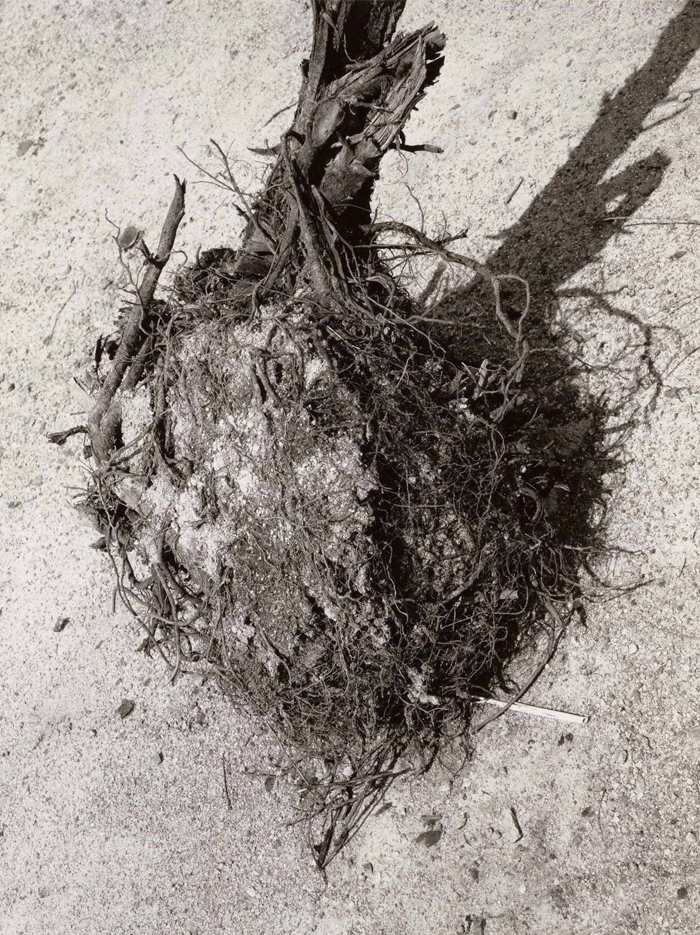
Robert Adams, Landfill, Pomona, California, 1985. Gelatin silver print; Image: 18 7/8 x 14 inches. Collection of The J. Paul Getty Museum, Los Angeles, California, © Robert Adams.
Although such works as Interstate 10, East Edge of Redlands, Ca. (1978), provide an occasional return to more abstract concerns, largely the photographs of the ‘80s signaled a more emotional response to subject that was undiminished and uncomplicated by formal, artistic imperatives. The uneasy alliance of aesthetics and ecological catastrophe in Burning Oil Sludge North of Denver seems to have reached an untenable point in works such as Vandalized Cactus, Redlands, Ca. (1982). Having succumbed to sports-obsessed vandals, a dismembered cactus lays in a dirt road near a grove of orange trees topped by telephone poles. With grim poetics symbolizing nature’s fate in the face of unrestrained human prosperity, Adams heightens the tension between human need and the end of nature. There is scant beauty to console us; even the verdant citrus trees seem obscene. In content and composition, Vandalized Cactus and Landfill, Pomona could be seen as critical predecessors to Adams’ present photographs of deforestation.
Throughout, Adams always insists, however, that “beauty in this world has not been eclipsed,” and indeed believes beholding the sheer beauty of nature can be a strong motivator for preserving and protecting it, as well as making the “suffering tolerable.”11 Flowering trees, delicate wintry branches, vast stretches of silvery ocean that often fill entire frames with shape, pattern, and light show up with regularity in the exhibition. Some contain “warning labels,” like the thin horizontal strip of tract housing behind a full-frame foreground flowering shrub in Redlands, California (1982).
From the section of the exhibition entitled West from Columbia, the huge old fir’s tentacles in Sitka Spruce, Cape Bland (1999) reach out anthropomorphically to shield spindly new trees from their possible future fate. Such photographs suggest Adams understands that the unqualified celebration of beauty when so much is threatened would be naïve and unacceptable. During a voice- over commentary in an exhibition video entitled State of the Forest (after his 2005 book), Adams comments that he wanted to “register the irreparable crime” of old-growth deforestation by the timber industry in the Pacific Northwest.
Before, he explains, he always let “the visual rule,” but now he is “not interested in being fair when it comes to eco-cide.” He records indescribable desolation, what he calls “scenes of butchery”:
What I hoped to do was to show what seemed to be going terribly wrong in a place I cared about a lot, but simultaneously to suggest that there are elements that remained safe, clean, beautiful, and would never be destroyed.12
Although Adams’ book was not presented in the exhibition, some of its images could be glimpsed in the accompanying documentary. In State of the Forest, Adams records photograph after photograph of land and trees stripped for corporate profit. Ugliness pervades the gutted ravines and eroded hillsides, littered with logging cables, monstrous cutting equipment, and high- tension power lines. These images recall Matthew Brady’s grisly photographs of Civil War battlegrounds, as fallen and amputated trees are strewn like hideously discarded corpses in the desecrated landscape.
A fourth gallery at the Getty provided stark contrast but also historical context for Adams’ indictment of the timber industry. In it, images by early American photographers like Timothy O’Sullivan, Carlton Watkins, and Darius Kinsey were displayed. For many of these artists, commerce—not its impact on nature—was the significant subject of their landscape photos. Kinsey in fact documented—without any hint of guilt or pessimism—the felling of old growth forests in the Pacific Northwest during the late 19th and early 20th century. As fellow photographer and influential photography curator John Szarkowski has pointed out, these photographers were the “last to practice the art of photography in a state of philosophical innocence.”13 Since this era, landscape photography has capitulated to the kind of elevated concern for nature’s continued survival that we see in Adams.
For over thirty years, Adams has clearly wrestled with his love for beauty, both formal and intrinsic, while photographing both the profaned and untrammeled aspects of his native landscape. Too astute of mind and too fine an artist/poet to abandon his artistic sensibilities in favor of straightforward journalistic reportage, he has however commented, “If we continue to make pictures we will contrive to make patterns of disaster.”14
Seeming contradictorily, the latest photographs of ecological devastation abound with teeming textures, delicate lines, superb compositional skills, and the technical virtuosity of his gelatin silver prints for which he is revered. As with the early formalist works on Colorado and California, the newer photographs often allow their sensuality to blind us to truth. Adams has by no means “solved” the conflict inherent in the presentation of terrible acts as beautiful, nor would that necessarily be his desire. The real difference between past works and those of the present is that the formal abstract logic and balance (even playfulness) of line and shape that constrained the transgressed subject from fully speaking when part of a larger artistic scheme, has given way to decentered compositions in which the subject’s voice is left intact.
The deforestation photographs seem deliberately out of balance, diffuse, and disordered. His tree subjects, scattered and discarded, reinforce the message of environmental holocaust. No longer supported by formal constructs and the resultant ambiguity about the actual deeds, the viewer feels unable to indulge in any sublime pleasures. In still other photos, the stumps and uprooted firs take center stage and are fully present as subjects in their own right; there is no longer a formal hierarchy that qualifies the subject as conditional to artistic experience. The images first read as acts of violence.
His heightened sense of observation and emotion as well as an unwillingness to disallow the “veil of beauty” to mask the brutality and the magnitude of global ecological problems help—contra formalism—to re-order our sense of beauty. Perhaps beauty resides in exposing those who would wantonly destroy the earth’s remaining natural resources for financial gain. Certainly, it would seem Robert Adams has found “what photography can do with it.”
Constance Mallinson is a Los Angeles based painter and critic
